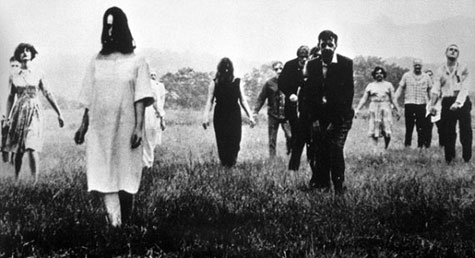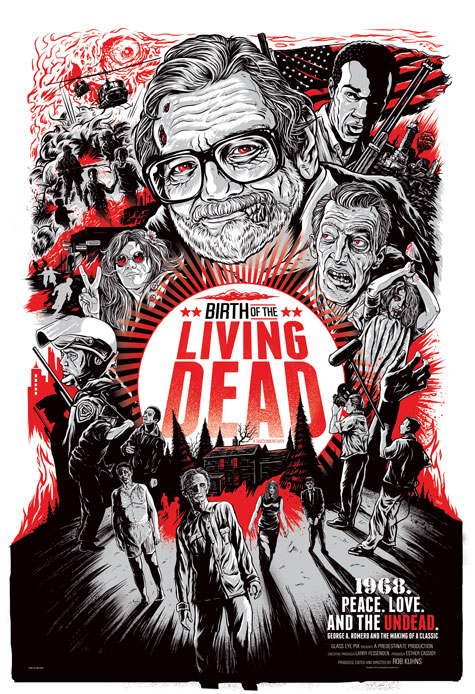From movies to comics and video games to hit TV shows, zombies have been swarming all over popular culture for the last couple of decades in a fury of brain eating, moaning and unstoppable, civilisation-ending shuffling. But with the zombie apocalypse such a standard, pervasive trope in modern genre entertainment it’s easy to forget where it all began—in the early days of horror cinema the zombie was a very different figure; a slightly laughable and much more ghostly one, based largely on misinterpreted Haitian mythology, and depicted in b-movie flicks such as White Zombie (1932) and Revolt of the Zombies (1936).
It took the 28 year old, and then very unknown, TV ad director George A Romero to re-define the zombie into the classic creature we know now, with the ultra low budget classic Night of the Living Dead (1968). Now, nearly half a century later, a new documentary film Birth of the Living Dead takes a look back at not just the unique filmmaking experience that Romero and his crew of guerrilla filmmakers undertook, but also at the movie’s just as revolutionary social commentary and lasting cultural impact.
As a documentary movie Birth of the Living Dead does little new in itself, relying on well chosen and arranged interview clips with cast and crew members as well as film scholars and critics to tell the story of Night’s production and legacy, in a style familiar to anyone that’s watched well made ‘making of’ DVD extras. Its only real stylistic quirk is in its occasional use of simple animations—the film’s makers were able to get hold of a number of behind the scenes production shots, but as they explained at the Q&A following the opening night screening at New York’s IFC there was some confusion over who owned them or held the rights, so in order to avoid any copyright problems they got an artist to trace over the photos, transforming them into pulpy 50s era comic book style images and adding little flourishes of animation. The end result is effective if somewhat clichéd (and familiar in some ways to anyone that has seen another recent documentary The Bill Hicks Story) and an understandable work-around, but on hearing why it was done it’s hard not to wish that those original photos were on display—especially as the story behind Night’s unique production is perhaps Birth’s most compelling and fascinating aspect.
Shot on a budget of just $114,000 and almost entirely on location in the Pennsylvania countryside, Night of the Living Dead would define the essence of independent filmmaking for generations to come. Beyond just being a group of plucky film geeks out to shoot a low budget horror flick, it became a community project in a very real sense, with Romero calling on friends, neighbours and business associates from his hometown of Pittsburgh to come down and get involved with the shoot. The enthusiastic response he got not only made the film possible, but shaped its content and nature in ways that would have been hard to predict or plan. Calling in locals to be zombie-extras is a no brainer (and a tactic still used today on lower budget productions such as Shawn of the Dead), but Romero also called in favours from local tradesmen to help with set building, and even a local butcher to supply animal carcass and entrails for the film’s (at the time) highly graphic gore sequences.
But perhaps the most significant volunteer was Bill Cardille, a local TV presenter best known for introducing late night horror movies, but who had also worked on TV in Pittsburgh for years in a variety of roles, including news presenting. Drawing on this experience Cardille played a TV news reporter investigating the reports of zombie attacks and the local police’s attempts to deal with the problem. Similarly Charles Craig—a writer and actor with experience of radio broadcasting—offered not only to play a TV anchorman, but to write all of his dialogue. Together Cardille and Craig give the movie a much needed believable air; guiding the audience through the film’s fantastic elements in a familiar manner, grounding what could easily have been just another over the top horror move with a sinisterly realistic edge, and giving Hollywood a story telling tool that is still used today.

Another area where Birth of the Living Dead excels is in its examination of the social and historical background to Night of the Living Dead. Romero wanted the film to reflect the tumultuous, tense atmosphere of life in the US at the end of the 1960s, when it felt to him like “there was a good deal of a sort of anger. Mostly that the 60s didn’t work. You know, we thought we had changed the world or were part of some sort of a reform that was going to make things better. And all of a sudden it wasn’t any better. It wasn’t any different.”
Birth captures this with the use of archival footage of the Vietnam war, civil rights protests and the riots in Detroit along with iconic rock music from the time to not only try and submerge the audience in the upheaval of the time, but also to help them understand why Night’s violent imagery—itself often shot to look like news footage—was so starkly and controversially relevant at the time of release.
One aspect of Night of the Living Dead’s imagery that stands out even today, and has been so closely associated with the film since it’s release, is its portrayal of race. Interestingly though, Birth of the Living Dead reveals that this wasn’t exactly planned. The decision to cast the African American actor Duane Jones as Peter, the movie’s lead, was revolutionary enough in itself for the time, but to never refer to his race in the dialogue was truly groundbreaking. Film critic and academic Elvis Mitchel describes seeing the movie when he was 10 in Detroit not long after the city had been shaken by racial violence as like “hearing Public Enemy for the first time…It’s just that kind of, oh my God, that electricity.”
Birth’s most interesting reveal is Romero’s claim that this had never been the movie’s intention—Jones was picked because he was available and known to the crew as a friendly and professional actor, and prior to that the script made no mention of his (or any of the other characters’) race. Intentional or not, the movie’s portrayal of both Peter as a rational, capable hero and the lynch mob style mentality of the zombie-hunting militia at the film’s disturbing conclusion, make Night of the Living Dead one of the period’s most interesting and challenging movies to confront the issue of race relations in America.

In many ways it’s this legacy of social commentary—that Romero would expand upon with his scathing portrayal of shopping mall consumerism in the follow-up Dawn of the Dead—that separates modern zombie films from Night of the Living Dead. While directors today are eager to stick to Romero’s zombie rules and tropes, they often ignore the opportunity to say something interesting about modern society, concentrating more on the opportunities for violence, escapism, and interpersonal drama (yes, The Walking Dead, I’m looking at you) that the zombie apocalypse brings. It’s a regrettable development that threatens to reduce the zombie genre to just another hollow and over-played sub-genre, but it’s something that Birth of the Living Dead does its best to fight off. Let’s hope the next generation of both zombie movie creators and their fans are paying attention.
When he’s not writing for Tor.com, Tim Maughan writes science fiction—his critically acclaimed book Paintwork is out now, and has been picking up support from the likes of Cory Doctorow and Ken MacLeod. So you should probably go buy it already.










